In the quest for a meaningful and fulfilling life, many turn to philosophy for guidance. One ancient school of thought that has experienced a resurgence in recent years is Stoicism. This ancient Greco-Roman philosophy teaches individuals how to live a life of virtue, resilience, and tranquility in the face of life’s challenges.
One of the most accessible and insightful books on Stoicism is “Stoicism and the Art of Happiness” by Donald Robertson. In this article, we will explore the key concepts of Stoicism as presented in the book and examine how they can help us lead a more fulfilling life.
Overview of “Stoicism and the Art of Happiness”
“Stoicism and the Art of Happiness” is a comprehensive guide to understanding and applying the principles of Stoicism in our modern lives.
Donald Robertson, a cognitive-behavioral psychotherapist and expert on Stoicism, provides a practical and accessible introduction to this ancient philosophy. The book is divided into three parts, each focusing on a different aspect of Stoicism.

Part One: The Philosophy of Stoicism
The first part of the book introduces the basic tenets of Stoicism, including its history, key figures, and core principles. Stoicism was founded in Athens by Zeno of Citium in the early 3rd century BC and was later developed by philosophers such as Epictetus, Seneca, and Marcus Aurelius.
The Stoics believed that the key to a happy life lies in living in accordance with nature and accepting the things we cannot change.
One of the central concepts of Stoicism is the dichotomy of control, which distinguishes between things that are within our control (such as our thoughts and actions) and things that are outside our control (such as the weather or other people’s opinions).
According to the Stoics, we should focus our attention and efforts on the things we can control and accept the things we cannot change with equanimity.
Another key concept of Stoicism is the idea of living in accordance with nature.
This means living in harmony with the natural order of the universe and fulfilling our role as rational beings. According to Stoic philosophy, we should strive to cultivate virtues such as wisdom, courage, justice, and temperance, which are essential for living a virtuous and happy life.
Part Two: The Stoic Way of Life
The second part of the book explores how we can apply the principles of Stoicism to our daily lives. Robertson discusses various Stoic practices and techniques that can help us cultivate a Stoic mindset and cope with life’s challenges.
These include practices such as negative visualization, which involves imagining the worst-case scenario in order to appreciate what we have, and the practice of self-denial, which involves voluntarily depriving ourselves of certain pleasures in order to build resilience.
Robertson also discusses the importance of maintaining a sense of perspective and detachment from external events. According to Stoic philosophy, our happiness should not depend on external circumstances, such as wealth or fame, but on our own inner virtues and values.
By cultivating a sense of inner peace and contentment, we can find happiness even in the midst of adversity.
Part Three: Stoicism in Practice
The final part of the book offers practical advice on how to incorporate Stoic principles into our daily lives. Robertson provides a step-by-step guide to applying Stoic techniques, such as mindfulness meditation and journaling, to cultivate a Stoic mindset.
He also discusses how Stoicism can help us navigate difficult emotions such as anger, anxiety, and grief, and how it can improve our relationships with others.
Overall, “Stoicism and the Art of Happiness” is a comprehensive and insightful guide to Stoic philosophy. Robertson’s writing is clear and engaging, making complex philosophical concepts accessible to a wide audience.
Whether you are new to Stoicism or a seasoned practitioner, this book offers valuable insights and practical advice for living a happier and more fulfilling life.
Conclusion
In conclusion, “Stoicism and the Art of Happiness” is a must-read for anyone interested in Stoic philosophy and its practical applications. Donald Robertson’s book offers a comprehensive and accessible introduction to Stoicism, exploring its history, key concepts, and practical techniques.
By applying the principles of Stoicism to our daily lives, we can cultivate a sense of inner peace and resilience that can help us navigate life’s challenges with grace and dignity.
Whether you are seeking personal growth, greater resilience, or simply a deeper understanding of the human condition, “Stoicism and the Art of Happiness” offers valuable insights and guidance that can benefit anyone willing to embark on this philosophical journey.
